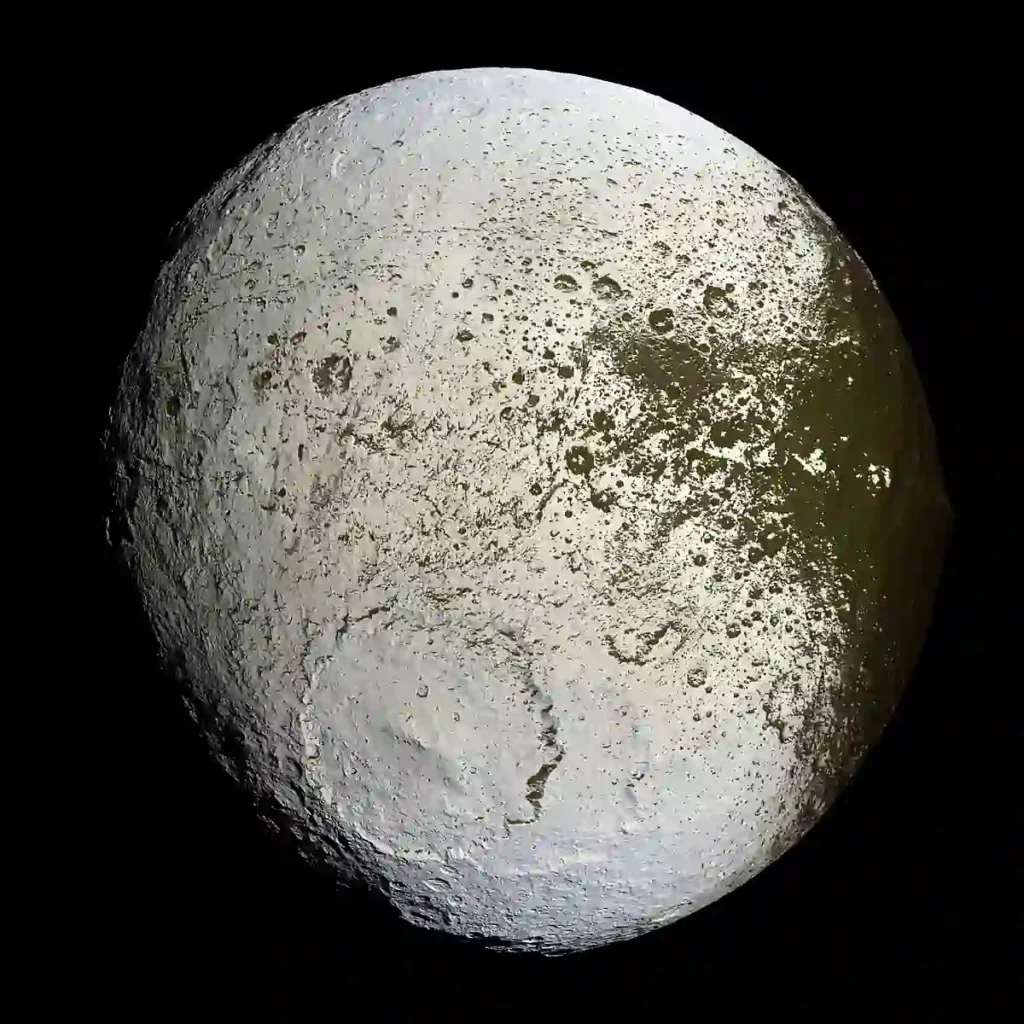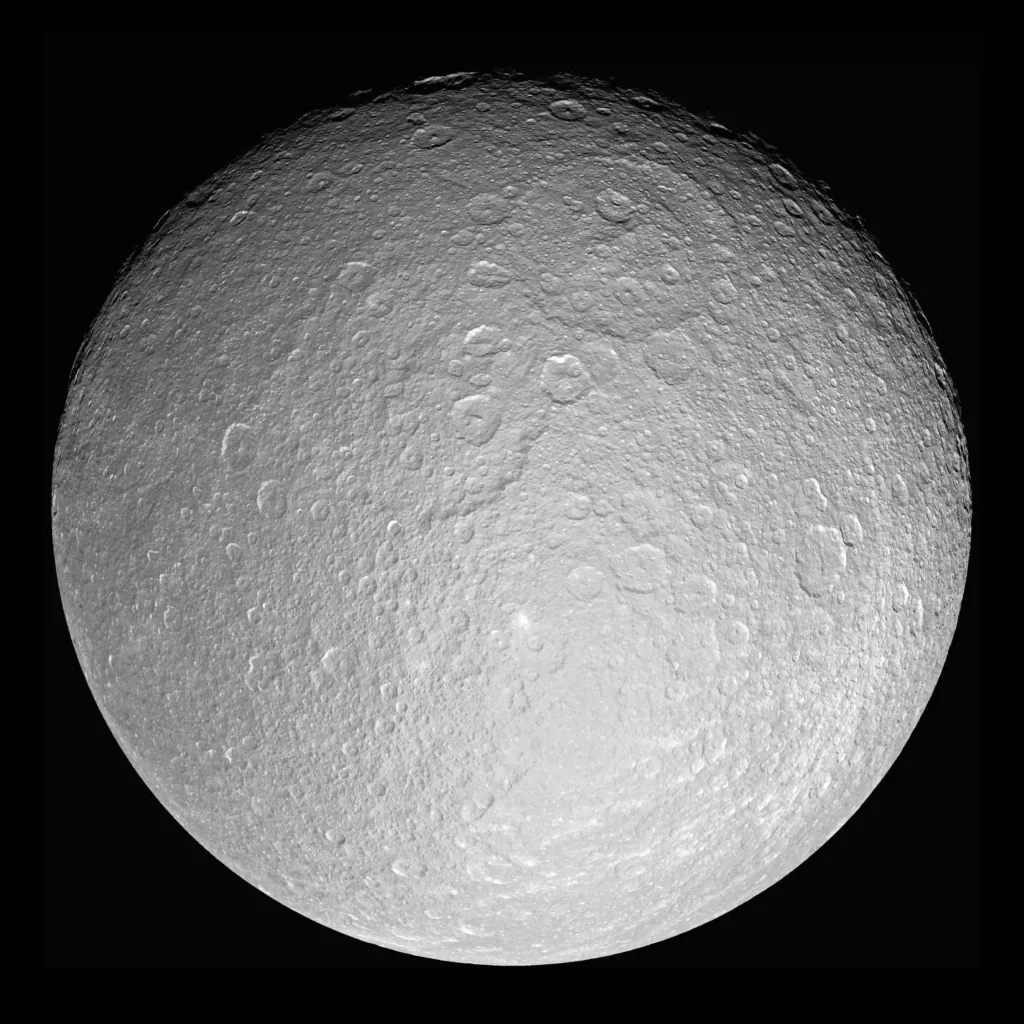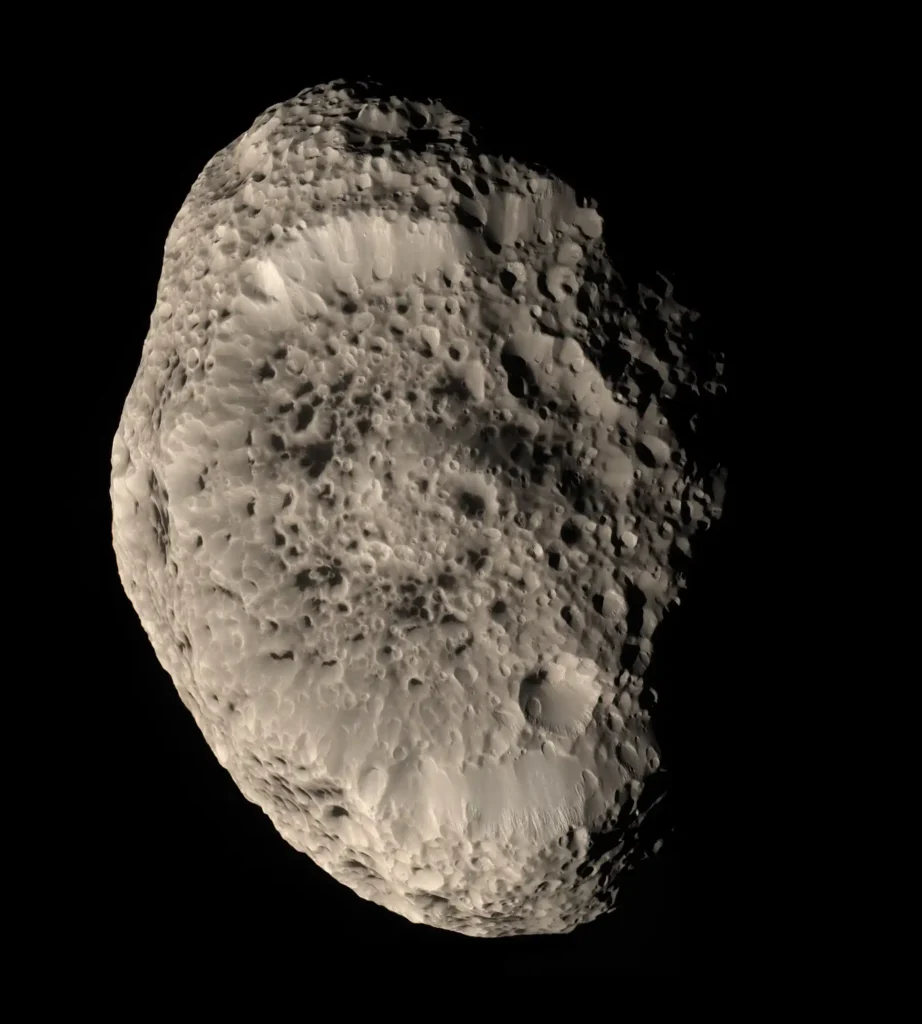Saturn

Saturn is the sixth planet from the Sun and the second-largest in our Solar System. Known for its stunning ring system and unique characteristics, Saturn has fascinated astronomers for centuries.
I. Facts about Saturn
Position and Size of Saturn in the Solar System
Saturn orbits the Sun at an average distance of about 1.4 billion kilometers (9.5 AU). Its size is substantial, with a diameter of 120,536 km, making it nearly 9.5 times the diameter of Earth but slightly smaller than Jupiter.
Gas Giant Classification
As a gas giant, Saturn is composed primarily of hydrogen and helium with no solid surface, similar to Jupiter but with unique characteristics.
Mass and Density Comparison
Saturn’s mass is about 95 times that of Earth but only one-third of Jupiter’s. Its density is significantly low, even lower than water, meaning it could float if placed in a large enough body of water.
Can Saturn Float in Water?

The density of Saturn is 0.687 grams per cubic centimeter, which is lower than that of water, which is 1 gram per cubic centimeter. According to physics, an object with a lower density than water will float on water. It means Saturn can float in a large body of Water.
Orbital Distance and Period
Saturn’s average distance from the Sun is 1.4 billion km, and it completes an orbit every 29.5 Earth years.
Storms on Saturn

Saturn experiences violent storms, including the Great White Spot, a periodic storm larger than Earth.
Why It Was Named Saturn

Named after the Roman god of agriculture, Saturn’s symbol (♄) represents a sickle, reflecting the mythology.
Age of Saturn
Saturn formed around 4.5 billion years ago and is similar in age to the rest of the Solar System.
Visibility in Earth’s Night Sky

Saturn is visible in the night sky as a bright, yellowish object and is easily seen with a telescope or even the naked eye.
II. Physical Characteristics of Saturn
- Composition of Hydrogen and Helium
Like Jupiter, Saturn is mostly composed of hydrogen (96%) and helium (3%), with trace elements. - No Definite Surface
Saturn’s gaseous composition lacks a true surface, transitioning gradually from gas to liquid under increasing pressure. - Oblate Spheroid Shape
Due to its rapid rotation, Saturn is an oblate spheroid, meaning it has a noticeable bulge at the equator. Jupiter is another example of an oblate spheroid planet. - Density
With a density of 0.687 g/cm³, Saturn is the only planet in our Solar System with a density lower than that of water. - Pale Yellow Hue
The planet’s yellowish color comes from ammonia crystals in its upper atmosphere and small quantities of methane.
III. Formation and Migration of Saturn
Saturn, like other gas giants, formed around 4.5 billion years ago through a process called core accretion. Here’s a breakdown of how Saturn came to be:
1. Formation of a Protoplanetary Disk
- After the Sun formed from the collapse of a gas and dust cloud, leftover materials created a rotating protoplanetary disk around it. This disk contained gas, dust, and other particles that would later form planets.
2. Core Accretion Phase
- Within this disk, dust and ice particles began to collide and stick together, gradually forming larger and larger bodies called planetesimals. In the region where Saturn formed, beyond the “frost line” (a distance far enough from the Sun for volatile compounds to condense), these planetesimals were able to accumulate ices in addition to rocky material.
- These planetesimals eventually coalesced into a large, rocky-icy core, with a mass roughly 10 times that of Earth. This core was massive enough to exert a strong gravitational pull on surrounding gas in the protoplanetary disk.
3. Rapid Gas Accretion
- Once Saturn’s core reached a sufficient size, it began to pull in large amounts of hydrogen and helium gas from the surrounding disk. This rapid gas accretion phase allowed Saturn to grow to its massive size, making it a gas giant.
- Unlike terrestrial planets, Saturn did not develop a solid surface but rather a thick, gaseous envelope.
4. Slowing Gas Accretion
- As Saturn grew, the gas in the protoplanetary disk started to thin out due to solar winds from the young Sun, which gradually dispersed the remaining gas. Saturn’s growth slowed, and it reached its current mass, stopping short of accumulating enough material to ignite fusion like a star.
5. Formation of Rings and Moons
- Some theories suggest that after Saturn’s formation, gravitational interactions with leftover planetesimals and icy bodies led to the formation of its rings and moons. The rings may have originated from icy bodies that were either torn apart by Saturn’s strong gravity or shattered during collisions with other celestial objects.
- Saturn’s moons likely formed from the remaining gas and dust in its orbit, with the largest, Titan, accumulating significant material to form a dense atmosphere.
6. Migration
- Saturn, like Jupiter, may have migrated inward and outward during its early development, reshaping the Solar System’s structure. This movement could have helped scatter smaller bodies, influencing the formation of the asteroid belt and other planetary positions.
IV. Composition of Saturn
Saturn, a gas giant, is primarily composed of hydrogen and helium, along with trace amounts of other elements and compounds. The composition of Saturn’s atmosphere, its deeper layers, and its core vary significantly, which affects its overall structure, appearance, and even its magnetic field. Here’s a detailed look at each of Saturn’s primary compositional layers:
1. Atmosphere
- Hydrogen (H₂): About 96% of Saturn’s atmosphere is composed of molecular hydrogen, the lightest and most abundant element in the universe.
- Helium (He): Roughly 3% of Saturn’s atmosphere is helium. However, helium is more concentrated deeper within Saturn, as it gradually separates from hydrogen and sinks inward.
- Methane (CH₄): Although present in trace amounts, methane is significant because it contributes to Saturn’s pale yellow hue by absorbing specific wavelengths of sunlight.
- Ammonia (NH₃) and Ammonium Hydrosulfide (NH₄SH): Ammonia forms clouds in the upper layers, while ammonium hydrosulfide forms clouds at deeper levels, giving Saturn its banded, layered appearance.
- Water Vapor (H₂O): Water vapor exists in the lower cloud layers, and in liquid or solid form deep within the planet. Saturn’s lack of a solid surface means that water doesn’t form seas or lakes, but it plays a role in cloud formation and storm systems.
2. Molecular Hydrogen Layer
- Gaseous Hydrogen Layer: Beneath the visible atmosphere lies a thick layer of gaseous hydrogen, extending thousands of kilometers below the cloud tops. Here, hydrogen remains in its molecular form but is compressed as pressure increases with depth.
- Transition to Metallic Hydrogen: As depth and pressure increase, the hydrogen layer thickens and eventually transforms into metallic hydrogen. This transition marks the shift between the outer molecular hydrogen layer and the metallic hydrogen layer.
3. Metallic Hydrogen Layer
- Metallic Hydrogen Composition: Under immense pressure (about 1–2 million times Earth’s atmospheric pressure), hydrogen atoms are forced so close together that their electrons become free-moving, allowing hydrogen to act like an electrically conductive liquid metal.
- Electrical Conductivity and Magnetic Field Generation: This metallic hydrogen layer is responsible for generating Saturn’s magnetic field. It also creates an electrically conductive environment that powers Saturn’s dynamo effect, producing a strong, symmetric magnetosphere.
- Helium Rain: In the metallic hydrogen layer, helium tends to separate out and form droplets, which then “rain” down toward the core. This “helium rain” releases additional energy, contributing to Saturn’s excess heat.
4. Core
- Rock and Ice Core Composition: Saturn’s core is believed to be composed of a dense mix of iron, nickel, silicon, and oxygen compounds, as well as rock and ice. Estimates suggest the core is about 10 to 20 times the mass of Earth.
- High Temperatures and Pressure: Conditions in the core are extreme, with temperatures estimated to reach around 12,000°C (21,600°F) and pressure millions of times greater than Earth’s surface.
- Source of Heat: The gravitational compression and helium rain within the core release substantial heat, which rises through Saturn’s outer layers and contributes to the planet’s overall heat emission. Saturn radiates more heat than it receives from the Sun due to this process.
5. Trace Compounds and Elements
- Phosphine (PH₃): Phosphine is a minor component in Saturn’s atmosphere, but it’s intriguing because it requires very high temperatures to form, indicating it likely originates from deeper layers and is transported upward.
- Hydrocarbons: Hydrocarbons like ethane and acetylene are created in Saturn’s upper atmosphere due to interactions with solar ultraviolet (UV) light and cosmic rays, adding complexity to Saturn’s cloud chemistry and atmosphere.
- Nitrogen (N₂): Small amounts of nitrogen are also present in Saturn’s upper atmosphere, though not as prevalent as on Titan, Saturn’s largest moon.
Composition Compared to Earth
- Lack of a Solid Surface: Unlike Earth, which has a solid surface and distinct crust, mantle, and core, Saturn’s composition is primarily gaseous and fluid, with only a dense core at its center.
- Lower Density: Saturn’s overall density is less than that of water (about 0.687 g/cm³), meaning it would float if placed in a sufficiently large body of water. This low density results from its composition being mostly hydrogen and helium, the lightest elements in the universe.
Significance of Saturn’s Composition
Comparison with Jupiter: Saturn’s composition is similar to Jupiter’s but contains a higher proportion of heavy elements and less metallic hydrogen, likely due to its smaller mass and slightly different formation conditions.
Planetary Formation Insight: Saturn’s makeup reflects the primordial composition of the early Solar System, offering clues about how gas giants form and evolve.
Heat and Weather Dynamics: The unique composition and internal processes, like helium rain, contribute to Saturn’s heat emission and weather patterns, including massive storms and periodic disturbances like the Great White Spot.
V. Planetary Rings of Saturn
Saturn’s rings are the most extensive and complex in the Solar System.
- Diameter and Thickness
The rings stretch 282,000 km across but are only about 10 meters thick. - Element Composition
Composed mainly of ice particles with some rocky debris, the rings are structured into seven primary sections with gaps and divisions. - Formation
The rings are thought to be remnants of comets, asteroids, or shattered moons that were torn apart by Saturn’s gravity.
VI. Magnetosphere of Saturn
Saturn’s magnetosphere, the region dominated by its magnetic field, is one of the largest and most powerful in the Solar System, though smaller than Jupiter’s. It plays an essential role in Saturn’s environment and interacts with solar winds, Saturn’s rings, and its many moons.
1. Structure and Strength of Saturn’s Magnetosphere
- Origin: Saturn’s magnetic field is generated by dynamo action within its deep interior, where metallic hydrogen flows under immense pressure. This motion creates electric currents, which, in turn, generate Saturn’s magnetic field.
- Size and Shape: Saturn’s magnetosphere extends about 1 million kilometers (600,000 miles) toward the Sun, influenced by solar winds, and stretches even farther on its night side.
- Strength: Saturn’s magnetic field strength is about 578 times stronger than Earth’s but significantly weaker than Jupiter’s. Notably, Saturn’s magnetic field is nearly perfectly aligned with its rotational axis, a unique feature among planets.
2. Composition and Features
- Bow Shock: Saturn’s magnetosphere forms a bow shock where incoming solar wind particles are deflected around it, much like water flowing around a rock in a stream.
- Magnetotail: Saturn has a long magnetotail, a tail of magnetic influence that extends away from the Sun and is filled with charged particles from both Saturn’s rings and the solar wind.
- Auroras: The interaction of the magnetosphere with charged particles creates stunning auroras near Saturn’s poles. These are not only visually striking but also provide insight into the behavior of solar wind around Saturn.
3. Role of Saturn’s Magnetosphere in the Solar System
- Protecting Saturn and its Moons: Saturn’s magnetosphere acts as a shield against solar and cosmic radiation, protecting Saturn, its rings, and its moons from charged particles. This helps maintain stable conditions around moons like Titan and Enceladus, which have unique atmospheres and, in the case of Enceladus, potential subsurface oceans.
- Influence on Saturn’s Rings and Moons: Saturn’s magnetosphere interacts directly with its rings and moons, especially Enceladus. Enceladus’s plumes of water vapor and ice, which erupt from its south pole, feed charged particles into Saturn’s magnetosphere. These particles contribute to the plasma in Saturn’s magnetic field, influencing the planet’s auroras and magnetotail.
- Contributing to Solar System Dynamics: Saturn’s magnetosphere plays a role in the larger structure of the heliosphere, the region of space influenced by the solar wind. Saturn’s interaction with solar winds contributes to the shaping of the heliosphere and provides scientists with valuable insights into how magnetic fields work in planetary systems.
- Unique Auroral Studies: Observing Saturn’s auroras helps scientists understand the effects of the solar wind and magnetic fields on planetary atmospheres, especially in comparison with Earth’s and Jupiter’s auroras. This research is crucial for studying the behavior of magnetic fields on exoplanets and other systems in space.
4. Comparative Role with Other Planetary Magnetospheres
- Comparison with Earth and Jupiter: While Earth’s magnetosphere protects its atmosphere from solar winds, Saturn’s, like Jupiter’s, has a more complex interaction with its moons and rings. Jupiter’s magnetic field is the strongest of all planets and profoundly impacts its extensive moon system. Saturn’s magnetosphere, while weaker, similarly influences its moons, and studying it provides insight into gas giant magnetospheres.
5. Scientific Importance
- Probing Solar System Evolution: Understanding Saturn’s magnetosphere offers insights into the evolution of magnetic fields, both within our Solar System and around other stars. This knowledge has applications in understanding planetary habitability, atmospheric retention, and magnetic field dynamics on a cosmic scale.
VII. Structure of Saturn
Saturn’s structure is divided into:
- Outer layer of molecular hydrogen.
- Metallic hydrogen layer under extreme pressure.
- Dense core of rock and metal.
Saturn’s structure is layered and consists of an atmosphere, a series of gaseous layers, and a dense core at its center. The planet lacks a solid surface, as it is composed mainly of gases, similar to Jupiter. Here’s a breakdown of Saturn’s internal structure:
1. Atmosphere
- Composition: The outermost layer of Saturn is its atmosphere, which primarily contains hydrogen (about 96%) and helium (about 3%) with trace amounts of methane, ammonia, and other gases.
- Cloud Layers: Saturn’s atmosphere contains distinct cloud layers made of ammonia ice, ammonium hydrosulfide, and water ice, each forming at different altitudes and temperatures. These clouds create the yellowish, banded appearance seen on the planet’s surface.
- Wind Speeds: High-velocity winds, reaching up to 1,800 km/h (1,120 mph), create bands of swirling clouds and storms, including Saturn’s periodic Great White Spot.
2. Molecular Hydrogen Layer
- Beneath Saturn’s atmosphere lies a layer of molecular hydrogen (H₂), the gas phase of hydrogen. This layer extends thousands of kilometers deep, and as pressure increases, hydrogen becomes denser.
- Temperature and Pressure Increase: As we go deeper, the temperature and pressure within this layer increase significantly, gradually compressing the hydrogen.
3. Metallic Hydrogen Layer
- Transition from Molecular to Metallic Hydrogen: Under immense pressure at greater depths, the molecular hydrogen transitions into a metallic hydrogen state, where hydrogen atoms behave like liquid metal. This layer is exclusive to gas giants like Saturn and Jupiter, which have the mass and pressure needed to produce metallic hydrogen.
- Electrical Conductivity: Metallic hydrogen acts as a conductor, contributing to Saturn’s magnetic field by generating electric currents. This layer is also responsible for the dynamo effect that creates Saturn’s magnetosphere.
4. Core
- Composition: At the center of Saturn is a dense core composed of rock, ice, and heavy elements. This core is thought to be about 10 to 20 times the mass of Earth and consists of iron, silicon, oxygen, and other elements.
- Extreme Conditions: Temperatures in the core are estimated to reach up to 12,000°C (21,600°F), with pressures millions of times greater than at Earth’s surface.
- Core Size and Mass: The core is relatively small compared to the overall size of Saturn, but its mass is critical in anchoring the planet’s gravitational field and initiating the gas accretion that led to Saturn’s formation.
5. Layers Interaction and Heat Generation
- Internal Heat: Saturn generates excess heat from within, radiating more than twice the energy it receives from the Sun. This heat likely comes from two sources:
- Gravitational Compression: Saturn slowly contracts over time, which releases energy.
- Helium Rain: As helium separates from hydrogen in the outer layers, it sinks inward, releasing gravitational potential energy as heat.
Saturn’s layered structure is central to its appearance, magnetic field, and overall behavior. These layers interact with each other to create Saturn’s unique environment, from its stormy atmosphere to its powerful magnetosphere.
IX. Size and Mass of Saturn
Saturn’s mass is 95 times that of Earth and 1/3rd of Jupiter. With a diameter of 120,536 km, it’s only slightly smaller than Jupiter.
X. Stormy Atmosphere of Saturn
The storms on Saturn, including its iconic Great White Spot, are caused by complex interactions within its atmosphere, driven by several factors:
1. Heat from Saturn’s Core
- Unlike Earth, where the Sun primarily drives weather, Saturn generates a significant amount of heat from its core. This internal heat is a result of gravitational compression and the slow sinking of helium through liquid hydrogen layers. This energy warms Saturn’s lower atmosphere, fueling convection currents that contribute to turbulent weather patterns.
2. Rapid Rotation
- Saturn has an incredibly fast rotation, with a day lasting only 10.7 hours. This rapid spin creates strong Coriolis forces, which twist and organize storms into jet streams and zonal bands (similar to Jupiter’s belts and zones). The rotation leads to east-west winds, which can reach up to 1,800 km/h (1,120 mph), resulting in intense atmospheric turbulence and vortices.
3. Composition of the Atmosphere
- Saturn’s atmosphere is primarily composed of hydrogen and helium, with smaller amounts of methane, ammonia, and water vapor. In the middle and lower layers, the condensation of ammonium hydrosulfide and water creates cloud layers, where temperature differences lead to instability and the formation of storms.
4. Seasonal Changes
- Saturn’s axis is tilted about 27 degrees, which causes seasonal variations over its 29.5-year orbit around the Sun. As different hemispheres receive varying levels of sunlight over time, temperature gradients increase, fueling intense storms, especially during Saturn’s equinoxes.
5. The Great White Spot
- The Great White Spot is a massive storm that appears roughly every 30 years when the planet’s northern hemisphere moves into late summer. It is similar in nature to Jupiter’s Great Red Spot but is more transient. The Great White Spot arises from rising warm gases that interact with colder up
XII. Moons of Saturn
Saturn is home to a fascinating collection of 146 moons, each with unique characteristics and histories. Among them, a few stand out for their distinctive features and contributions to our understanding of the Solar System.
1. Titan

- Largest Moon of Saturn: Titan is Saturn’s largest moon and the second-largest moon in the Solar System, even larger than Mercury.
- Thick Atmosphere: Titan has a dense atmosphere rich in nitrogen with clouds of methane and ethane. It’s the only moon in the Solar System with a substantial atmosphere, which is four times denser than Earth’s.
- Liquid Lakes and Rivers: Titan hosts lakes, rivers, and seas of liquid methane and ethane on its surface, making it the only other body in the Solar System with stable liquid on its surface.
- Possibility of Life: Due to its organic-rich environment, scientists are interested in the potential for life in Titan’s atmosphere or even within a possible subsurface ocean of water and ammonia.
2. Enceladus

- Subsurface Ocean: Enceladus has garnered significant attention due to evidence of a global subsurface ocean beneath its icy crust. This ocean is believed to be kept warm by tidal heating from Saturn’s gravitational pull.
- Water Plumes: The Cassini spacecraft discovered geysers near Enceladus’s south pole, ejecting water vapor, organic compounds, and other particles into space. These plumes indicate hydrothermal activity, which could potentially support microbial life.
- Habitability Potential: Enceladus’s internal ocean, coupled with hydrothermal activity, makes it one of the most promising places to search for life beyond Earth.
3. Mimas

- “Death Star” Appearance: Mimas is known for its giant Herschel crater, which gives it a resemblance to the “Death Star” from Star Wars.
- Icy Composition: Mimas is composed mostly of ice, with very little rocky material. Its heavily cratered surface suggests it has been geologically inactive for most of its history.
- Internal Ocean Hypothesis: Recent data suggests there might be an ocean beneath Mimas’s surface, though this is still under investigation.
4. Iapetus

- Two-Toned Surface: Iapetus has a stark contrast between its two hemispheres: one is dark and carbon-rich, while the other is bright and icy.
- Equatorial Ridge: A unique ridge runs along much of Iapetus’s equator, rising up to 10 miles high, giving the moon a walnut-like appearance. The origin of this ridge remains a mystery.
5. Rhea

- Second-Largest Moon: Rhea is Saturn’s second-largest moon, with a heavily cratered and icy surface.
- Thin Atmosphere: Rhea has a very thin atmosphere composed of oxygen and carbon dioxide, discovered by the Cassini spacecraft.
- Possible Rings: There is some evidence suggesting that Rhea may have faint, thin rings around it—this would make it the only known moon with rings.
6. Tethys

- Odysseus Crater: Tethys is marked by a massive crater, Odysseus, which spans nearly half the moon’s diameter, and a large canyon system called Ithaca Chasma.
- Icy Surface: Tethys is primarily made of water ice, making it highly reflective and bright.
7. Hyperion

- Irregular Shape and Porous Surface: Hyperion is irregularly shaped, resembling a sponge due to its highly porous, cratered surface.
- Chaotic Rotation: Hyperion rotates in an unpredictable, chaotic manner due to its irregular shape and gravitational interactions with Titan.
8. Dione

- Icy Cliffs and Ridges: Dione has a surface marked by cliffs, ridges, and craters, suggesting it was once geologically active.
- Possibility of a Subsurface Ocean: Some scientists believe Dione may also have a subsurface ocean, similar to Enceladus.
Importance of Saturn’s Moons
Saturn’s moons provide a unique laboratory for studying planetary processes, including surface ice dynamics, volcanic activity, and potential subsurface oceans. Moons like Titan and Enceladus hold great interest for astrobiologists due to their potential habitability, making Saturn’s system one of the most intriguing regions in the Solar System for exploration.
XIV. Orbit and Rotation of Saturn
Saturn takes 29.5 Earth years to orbit the Sun, with a day lasting only 10.7 hours due to its rapid rotation. This rotation contributes to its oblate shape.
XV. Observations and Explorations
Early observations by Galileo Galilei revealed Saturn’s rings, though he couldn’t fully understand their nature. Over centuries, telescopes improved, leading to new discoveries, including Saturn’s moons and its atmospheric characteristics.
XVI. Flyby Missions
Spacecraft like Pioneer 11, Voyager 1 and 2, and Cassini provided unprecedented details about Saturn’s rings, atmosphere, and moons. Cassini, in particular, orbited Saturn from 2004 to 2017, delivering extensive data.
XVII. Telescopic Observations of Saturn
Modern telescopes and observatories have allowed for continued study of Saturn’s dynamic rings, atmosphere, and seasonal changes. Saturn’s visibility in the night sky has also made it a popular target for amateur astronomers.
Details in the Articles are collected from trusted Sources you can visit Wikipedia and NASA for more details.

“The best thing we found about this article is that Source of Information is mentioned too.”
Ya that is necessary to provide accurate details in our articles!